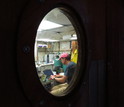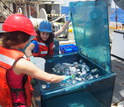Hola amigos: A VUELO DE UN QUINDE EL BLOG., hemos recibido información de la Fundación Nacional de Ciencia de Los Estados Unidos, dándonos a conocer los fertilizantes que ocultan los océanos, teniéndose en cuenta que el fósforo es una de las sustancias más comunes de La Tierra, y por su puesto las plantas marinas juegan un diminuto papel importante en el ciclo del fósforo.
El fósforo, nutriente esencial para todos los organismos vivos y los seres humanos requieren aproximadamente 700 miligramos por día, nosotros estamos preocupado por consumir lo suficiente, ya que es en la mayoría de los alimentos que comemos.
Los científicos que estudian el ciclo de fósforo marino han sabido que el fósforo fue absorbido por las plantas y los animales y lanzó de nuevo al agua de mar en forma de fosfato ; de como estas plantas y animales en decadencia y la muerte.
Sin embargo, un creciente cuerpo de investigación sugiere que los microbios en el océano transforman fósforo en formas que siguen siendo un misterio.
More information.....
http://www.nsf.gov/news/news_summ.jsp?cntn_id=135149&WT.mc_id=USNSF_51&WT.mc_ev=click
Tiny marine plants play major role in phosphorus cycle
 Credit and Larger Version |
Phosphorus is one of the most common substances on Earth.
An essential nutrient for every living organism--humans require approximately 700 milligrams per day--we're rarely concerned about consuming enough because it is in most of the foods we eat.
Despite its ubiquity and living organisms' dependence on it, we know surprisingly little about how it moves, or cycles, through the ocean environment.
Scientists studying the marine phosphorous cycle have known that phosphorus was absorbed by plants and animals and released back to seawater in the form of phosphate as these plants and animals decay and die.
But a growing body of research hints that microbes in the ocean transform phosphorus in ways that remain a mystery.
Hidden role of ocean's microbes
A new study by a research team from the Woods Hole Oceanographic Institution (WHOI) and Columbia University reveals for the first time a marine phosphorus cycle that is much more complex than previously thought.
The work also highlights the important but previously hidden role that some microbial communities play in using and breaking down forms of this essential element.
A paper reporting the findings is published this week in the journal Science.
"A reason to be excited about this elegant study is in the paper's last sentence: 'the environmental, ecological and evolutionary controls ...remain completely unknown,'" says Don Rice, program director in the National Science Foundation's (NSF) Division of Ocean Sciences, which funded the research through its Chemical Oceanography Program. "There's still a lot we don't know about the sea."
The work is also supported by an NSF Dimensions of Biodiversity grant.
"This is an exciting new discovery that closes a fundamental knowledge gap in our understanding of the marine phosphorus cycle," says the paper's lead author Ben Van Mooy, a biochemist at WHOI.
Much like phosphorus-based fertilizers boost the growth of plants on land, phosphorus in the ocean promotes the production of microbes and tiny marine plants called phytoplankton, which compose the base of the marine food chain.
Phosphonate mystery
It's been unclear exactly how phytoplankton are using the most abundant forms of phosphorus found in the ocean--phosphates and a strange form of phosphorus called phosphonates.
"Phosphonates have always been a huge mystery," Van Mooy says.
"No one's been able to figure out exactly what they are, and more importantly, if they're made and consumed quickly by microbes, or if they're just lying around in the ocean."
To find out more about phosphonates and how microbes metabolize them, the researchers took samples of seawater at a series of stations during a research cruise from Bermuda to Barbados.
They added phosphate to the samples so they could see the microbes in action.
The research team used ion chromatography onboard ship for water chemistry analyses, which allowed the scientists to observe how quickly microbes reacted to the added phosphate in the seawater.
"The ion chromatograph [IC] separates out the different families of molecules," explains Van Mooy.
"We added radioactive phosphate, then isolated the phosphonate to see if the samples became radioactive, too. It's the radioactive technique that let us see how fast phosphate was transformed to phosphonate."
Enter the microbes
The researchers found that about 5 percent of the phosphate in the shallow water samples was taken up by the microbes and changed to phosphonates.
In deeper water samples, which were taken at depths of 40 and 150 meters (131 feet and 492 feet), about 15 to 20 percent of the phosphates became phosphonates.
"Although evidence of the cycling of phosphonates has been mounting for nearly a decade, these results show for the first time that microbes are producing phosphonates in the ocean, and that it is happening very quickly," says paper co-author Sonya Dyhrman of Columbia University.
"An exciting aspect of this study was the application of the IC method at sea. In near-real-time, we could tell that the phosphate we added was being transformed to phosphonate."
Better understanding of phosphorus cycle
A better understanding of phosphorus cycling in the oceans is important, as it affects the marine food web and, therefore, the ability of the oceans to absorb atmospheric carbon dioxide.
The researchers say that solving the mystery of phosphonates also reinforces the need to identify the full suite of phosphorus biochemicals being produced and metabolized by marine microbes, and what physiological roles they serve for these cells.
"Such work will help us further resolve the complexities of how this critical element is cycled in the ocean," Dyhrman adds.
Grants from the Simons Foundation also supported the work.
-NSF-
Media Contacts Cheryl Dybas, NSF, (703) 292-7734, cdybas@nsf.gov
Erin Koening, WHOI, (508) 289-2271, ekoenig@whoi.edu
Erin Koening, WHOI, (508) 289-2271, ekoenig@whoi.edu
Related WebsitesNSF Grant: Dimensions: Collaborative Research: Biological Controls on the Ocean C:N:P ratios: http://www.nsf.gov/awardsearch/showAward?AWD_ID=1045966&HistoricalAwards=false
NSF Grant: Dissolved Phosphorus Processing by Trichodesmium Consortia: Quantitative Partitioning, Role of Microbial Coordination, and Impact on Nitrogen Fixation: http://www.nsf.gov/awardsearch/showAward?AWD_ID=1332898&HistoricalAwards=false
The National Science Foundation (NSF) is an independent federal agency that supports fundamental research and education across all fields of science and engineering. In fiscal year (FY) 2015, its budget is $7.3 billion. NSF funds reach all 50 states through grants to nearly 2,000 colleges, universities and other institutions. Each year, NSF receives about 48,000 competitive proposals for funding, and makes about 11,000 new funding awards. NSF also awards about $626 million in professional and service contracts yearly.
Useful NSF Web Sites:
NSF Home Page:
http://www.nsf.gov
NSF News:
http://www.nsf.gov/news/
For the News Media:
http://www.nsf.gov/news/newsroom.jsp
Science and Engineering Statistics:
http://www.nsf.gov/statistics/
Awards Searches:
http://www.nsf.gov/awardsearch/

The vessel Atlantic Explorer, used in the study, just before a research cruise to Barbados.
Credit and Larger Version

Tiny marine plankton form colonies in a variety of shapes visible to the naked eye.
Credit and Larger Version

Lead scientist Ben Van Mooy processed data aboard ship late into the evening.
Credit and Larger Version

Researchers place sampling bottles in a container that mimicks the sea's light and temperature.
Credit and Larger Version
_r.jpg)
The researchers' findings are described in the May 15, 2015, issue of the journal Science.
Credit and Larger Version
The National Science Foundation (NSF)
Guillermo Gonzalo Sánchez Achutegui
ayabaca@gmail.com
ayabaca@hotmail.com
ayabaca@yahoo.com
Inscríbete en el Foro del blog y participa : A Vuelo De Un Quinde - El Foro!

No hay comentarios:
Publicar un comentario